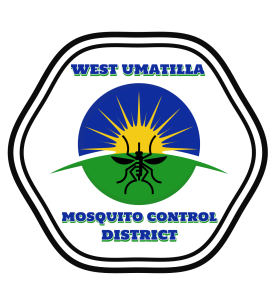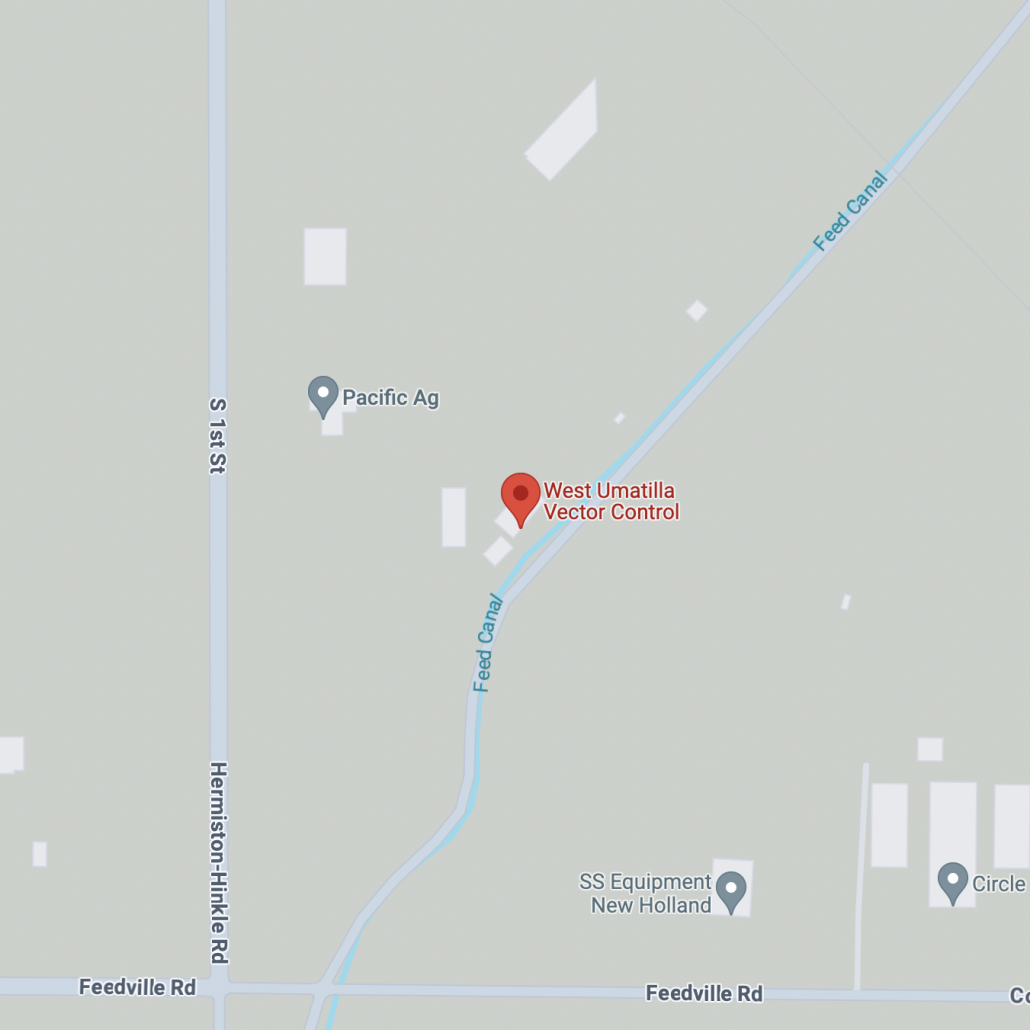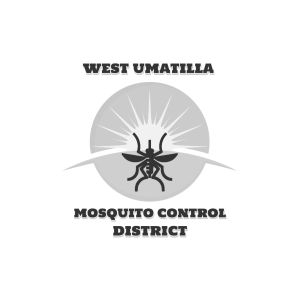different species of
mosquitoes in the world
species in the United States
species in Oregon
species documented in Umatilla County
Each mosquito species has a Latin scientific name, such as Anopheles quadrimaculatus. Anopheles is the “generic” name of a group of closely related mosquitoes and quadrimaculatus is the “species” name that represents a group of individuals that are similar in structure and physiology and capable of interbreeding. These names are used in a descriptive manner so that the name tells something about each mosquito. For example, Anopheles is Greek for “hurtful” or “prejudicial,” and quadrimaculatus is Latin for “four spots” for the four dark spots on the wings. Some species have common names as well as scientific names, such as Ochlerotatus taeniorhynchus, the “black salt marsh mosquito.”
Scientific investigators (taxonomists) are constantly looking for new mosquitoes, as well as reviewing previously identified specimens for new information or identifying characteristics. Better microscopic equipment developed in the past decades has improved the taxonomist’s ability to determine differences between species. Recently such a review by Dr. John Reinert (2000) led to a change in the name of many mosquitoes belonging to the genus Aedes. Using improved methods and over 30 years’ experience he elevated a subgenus of Aedes (Ochlerotatus) to the status of genus. This will require renaming many mosquitoes previously named Aedes to the genus Ochlerotatus and rewriting many taxonomic keys important to public health entomologists working in mosquito control.
The Name “Mosquito”
The Spanish called the mosquitoes “musketas,” and the native Hispanic Americans called them “zancudos.” “Mosquito” is a Spanish or Portuguese word meaning “little fly” while “zancudos,” a Spanish word, means “long-legged.” The use of the word “mosquito” is apparently of North American origin and dates back to about 1583. In Europe, mosquitoes were called “gnats” by the English, “Les moucherons” or “Les cousins” by French writers, while the Germans used the name “Stechmucken” or “Schnacke.” In Scandinavian countries mosquitoes were called by a variety of names including “myg” and “myyga” and the Greeks called them “konopus.” In 300 B.C., Aristotle referred to mosquitoes as “empis” in his “Historia Animalium” where he documented their life cycle and metamorphic abilities. Modern writers used the name Culex and it is retained today as the name of a mosquito genus. What is the correct plural form of the word mosquito? In Spanish it would be “mosquitos,” but in English “mosquitoes” (with the “e”) is correct.
Mosquito Life Cycle
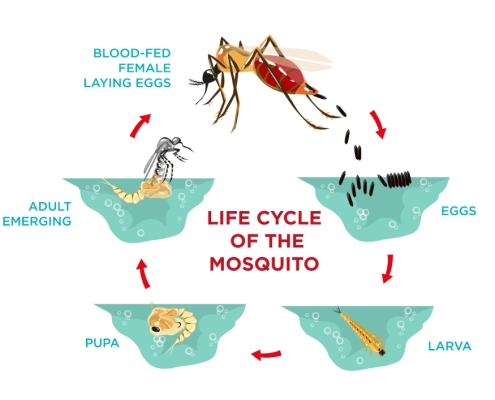
The mosquito goes through four separate and distinct stages of its life cycle: Egg, Larva, Pupa, and Adult. Each of these stages can be easily recognized by its special appearance.
How long each stage lasts depends on both temperature and species characteristics. For instance, Culex tarsalis, a common California (USA) mosquito, might go through its life cycle in 14 days at 70° F and take only 10 days at 80° F. On the other hand, some species have naturally adapted to go through their entire life cycle in as little as four days or as long as one month.
Egg: Eggs are laid one at a time or attached together to form “rafts.” They float on the surface of the water. In the case of Culex and Culiseta species, the eggs are stuck together in rafts of up to 200. Anopheles, Ochlerotatus and Aedes, as well as many other genera, do not make egg rafts, but lay their eggs singly. Culex, Culiseta, and Anopheles lay their eggs on the water surface while many Aedes and Ochlerotatus lay their eggs on damp soil that will be flooded by water. Most eggs hatch into larvae within 48 hours; others might withstand subzero winters before hatching. Water is a necessary part of their habitat.
Larva: The larva (plural “larvae”) lives in the water and comes to the surface to breathe. Larvae shed (molt) their skins four times, growing larger after each molt. Most larvae have siphon tubes for breathing and hang upside down from the water surface. Anopheles larvae do not have a siphon and lie parallel to the water surface to get a supply of oxygen through a breathing opening. Coquillettidia and Mansonia larvae attach to plants to obtain their air supply. The larvae feed on microorganisms and organic matter in the water. During the fourth molt the larva changes into a pupa.
Pupae: The pupal stage is a resting, non-feeding stage of development, but pupae are mobile, responding to light changes and moving (tumble) with a flip of their tails towards the bottom or protective areas. This is the time the mosquito changes into an adult. This process is similar to the metamorphosis seen in butterflies when the butterfly develops — while in the cocoon stage — from a caterpillar into an adult butterfly. In Culex species in the southern United States this takes about two days in the summer. When development is complete, the pupal skin splits and the adult mosquito (imago) emerges.
Adult: The newly emerged adult rests on the surface of the water for a short time to allow itself to dry and all its body parts to harden. The wings have to spread out and dry properly before it can fly. Blood feeding and mating does not occur for a couple of days after the adults emerge.
Egg Raft
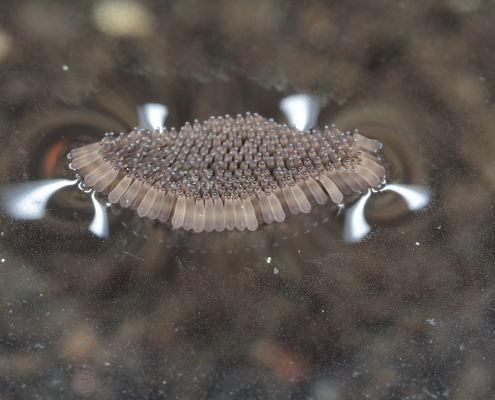 Many mosquitoes, such as Culex pipiens, lay their eggs on the surface of fresh or stagnant water. The water may be in tin cans, barrels, horse troughs, ornamental ponds, swimming pools, puddles, creeks, ditches, catch basins or marshy areas. Mosquitoes prefer water sheltered from the wind by grass and weeds.
Many mosquitoes, such as Culex pipiens, lay their eggs on the surface of fresh or stagnant water. The water may be in tin cans, barrels, horse troughs, ornamental ponds, swimming pools, puddles, creeks, ditches, catch basins or marshy areas. Mosquitoes prefer water sheltered from the wind by grass and weeds.
Culex mosquitoes usually lay their eggs at night over, sticking them together to form a raft of from 100 to 300 eggs. A raft of eggs looks like a speck of soot floating on the water and is about 1/4 inch long and 1/8 inch wide. A female mosquito may lay a raft of eggs every third night during its life span. Anopheles and many other mosquitoes lay their eggs singly on the water surface. Aedes and Ochlerotatus mosquitoes lay their eggs singly, usually on damp soil. Aedes and Ochlerotatus eggs are more resistant to drying out (some require complete drying out before the eggs will hatch) and hatch only when flooded with water (salt water high tides, irrigated pastures, treeholes flooded by rains, flooded stream bottoms). Anopheles, Culex and Mansonia eggs are susceptible to long periods of drying out. Tiny mosquito larvae emerge from the eggs within 24-48 hours almost in unison.
Larvae
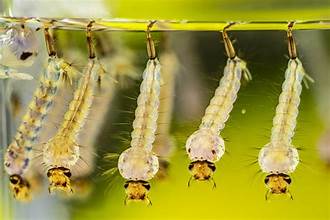 Mosquito larvae, commonly called “wigglers,” live in water from 4 to 14 days depending on water temperature.
Mosquito larvae, commonly called “wigglers,” live in water from 4 to 14 days depending on water temperature.
Larvae must come to the surface at frequent intervals to obtain oxygen through a breathing tube called a siphon. They are constantly feeding since maturation requires a huge amount of energy and food. They hang with their heads down and the brushes by their mouths filtering anything small enough to be eaten toward their mouths to nourish the growing larvae. They feed on algae, plankton, fungi and bacteria and other microorganisms. They breath at the water surface with the breathing tube up breaking the water surface tension. One mosquito species larva feeds on larvae of other mosquitoes: Toxorhynchites, the largest mosquito known, are predators of other mosquito larvae sharing their habitat. Their larvae are much larger than other mosquito larvae.
During growth, the larva molts (sheds its skin) four times. The stages between molts are called instars. At the 4th instar, the usual larva reaches a length of almost 1/2 inch and toward the end of this instar ceases feeding. When the 4th instar larva molts, it becomes a pupa.
Pupae
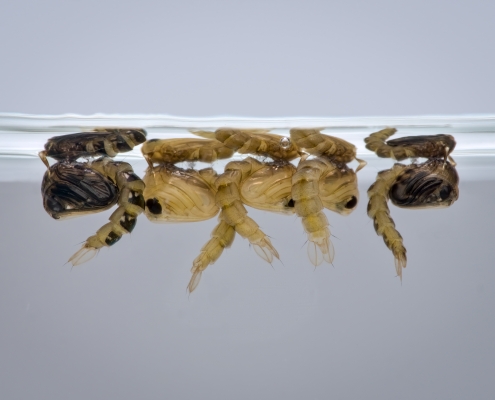 Mosquito pupae, commonly called “tumblers,” live in water from 1 to 4 days, depending upon species and temperature
Mosquito pupae, commonly called “tumblers,” live in water from 1 to 4 days, depending upon species and temperature
The pupa is lighter than water and therefore floats at the surface. It takes oxygen through two breathing tubes called “trumpets.” The pupa does not eat, but it is not an inactive stage. When disturbed, it dives in a jerking, tumbling motion toward protection and then floats back to the surface.
The metamorphosis of the mosquito into an adult is completed within the pupal case. The adult mosquito splits the pupal case and emerges to the surface of the water where it rests until its body dries and hardens.
Adult
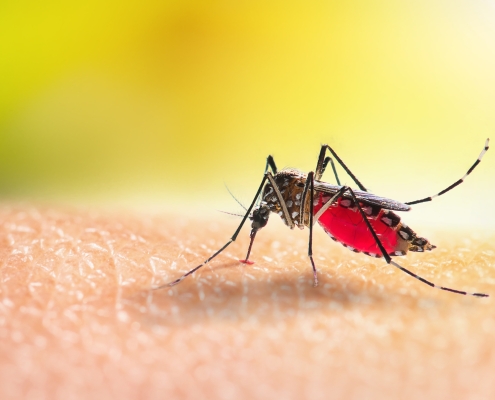
Only female mosquitoes require a blood meal and bite animals – warm or cold blooded – and birds. Stimuli that influence biting (blood feeding) include a combination of carbon dioxide, temperature, moisture, smell, color, and movement. Male mosquitoes do not bite, but feed on the nectar of flowers or other suitable sugar source. Acquiring a blood meal (protein) is essential for egg production, but mostly both male and female mosquitoes are nectar feeders. Female Toxorhynchites actually can’t obtain a bloodmeal and are restricted to a nectar diet. Of those female mosquitoes capable of blood feeding, human blood meals are seldom first or second choices. Horses, cattle, smaller mammals and/or birds are preferred.
Aedes and Ochlerotatus mosquitoes are painful and persistent biters. They search for a blood meal early in the morning, at dusk (crepuscular feeders) and into the evening. Some are diurnal (daytime biters) especially on cloudy days and in shaded areas. They usually do not enter dwellings, and they prefer to bite mammals like humans. Aedes and Ochlerotatus mosquitoes are strong fliers and are known to fly many miles from their breeding sources.
Culex mosquitoes are also painful and persistent biters, but prefer to attack at dusk and after dark. They readily enter dwellings for blood meals. Domestic and wild birds usually are preferred over man, cows, and horses. Culex nigripalpus is known to transmit Louis encephalitisto man in Florida. Culex mosquitoes are generally weak fliers and do not move far from home, although they have been known to fly up to two miles. Culex usually live only a few weeks during the warm summer months. Those females that emerge in late summer search for sheltered areas where they “hibernate” until spring. Warm weather brings them out again in search of water on which to lay their eggs.
Culiseta mosquitoes are moderately aggressive biters, attacking in the evening hours or in the shade during the day. Psorophora, Coquillettidia and Mansonia mosquitoes are becoming more pestiferous as an ever-expanding human population invades their natural habitats. Anopheles mosquitoes are persistent biters and are the only mosquitoes which transmit malaria to man.
